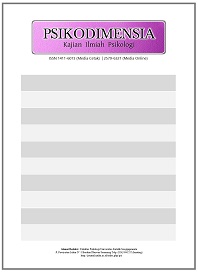Surviving the Unpleasant : Hope of the Child of Divorce
Abstract
Keywords
Full Text:
PDFReferences
Ahrons, C.R. (2007). Family ties after divorce: Long‐term implications for children. Family Process, 46, 53-65. https://doi.org/10.1111/j.1545-5300.2006.00191.x
Anderson, J. (2014). The impact of family structure on the health of children: effects of divorce. The Linacre Quarterly, 81(4), 378–387. https://doi.org/10.1179/0024363914Z.00000000087
Bailey, T. C., Eng, W., Frisch, M. B., & Snyder, C. R. (2007). Hope and optimism as related to life satisfaction. The Journal of Positive Psychology, 2(3), 168-175.
Bamford, C., & Lagattuta, K. H. (2012). Looking on the bright side: Children’s knowledge about the benefits of positive versus negative thinking. Child Development, 83(2), 667-682.
Clarke-Stewart, A. & Brentano, C. (2006). Divorce: Causes and consequences. London: Yale University Press.
Fischer, C. T. (2006). Qualitative research methods for psychologists: Introduction through empirical studies. Burlington, MA: Elsevier, Inc.
Gerring, J. (2007). Case study research principles and practices. New York: Cambridge University Press.
Goldstein, E. B. (13 Februari 2009). Sensation and perception. Cengage Learning. ISBN 978-0-495-60149-4.
Hutauruk, F., Ahmad, R., & Bentri, A. (2019). Children resilience in dealing with parental divorce based on the ability to regulate emotions and optimism. International Journal of Research in Counseling and Education, 4(1), 9-14.
Khan, S. N. (2014). Qualitative research method-phenomenology. Asian Social Science, 10(21), 298.
Li, M., Chang, E. C., & Chang, O. D. (2020). Beyond the role of interpersonal violence in predicting negative affective conditions in adults: An examination of hope components in Chinese college students. Journal of Interpersonal Violence. https://doi.org/10.1177/0886260520938515
Lopez, S. J., Snyder, C. R., Mayar-Moe, J. L., Edwards, L. M., Pedrotti, J. T., Janowski, et al. (2004). Strategies for Accentuating Hope. Dalam P. A. Linley & S. Joseph (Eds.), Positive psychology in practice (pp. 388-404). Hoboken, NJ: John Wiley & Sons.
Ozen, B., Ceyhan, O., & Büyükcelik, A. (2020). Hope and perspective on death in patients with cancer. Death studies, 44(7), 412-418.
Poerwandari, E. K. (2009). Pendekatan kualitatif untuk penelitian perilaku manusia. Depok: Lembaga Pengembangan sarana Pengukuran dan Pendidikan Psikologi (LPSP3) Fakultas Psikologi Universitas Indonesia.
Rand, K. L., & Cheavens, J. S. (2009). Hope theory. Dalam S. J. Lopez & C. R. Snyder (Eds.), Oxford library of psychology. Oxford handbook of positive psychology (p. 323–333). Oxford University Press.
Taylor, R., & Andrews, B. (2009) Parental depression in the context of divorce and the impact on children, Journal of Divorce & Remarriage, 50(7), 472-480, DOI: 10.1080/10502550902970579
Santoso, Agung S. (2012). Penerimaan stimulus oleh panca indera (Sensasi). Modul Psikologi SDM. Pusat Pengembangan Bahan Ajar-UMB. Tersedia di: http://pksm.mercubuana.ac.id/new/elearning/files_modul/94013-11-875122452273.doc.
Snyder, C. R. (2000). Handbook of hope: Theory, measures, and applications. San Diego, CA: Academic Press.
Snyder, C. R. (2002). Hope theory: Rainbows in the mind. Psychological inquiry, 13(4), 249-275.
Snyder, C.R., and Lopez, S.J. (2007). Positive psychology: The scientific and practical explorations of human strengths. California: Sage Publications Inc.
Snyder, C. R., Rand, K. L., & Sigmon, D. R. (2002). Hope theory: A member of the positive psychology family. Dalam C. R. Snyder & S. J. Lopez (Eds.), Handbook of positive psychology (pp. 257-276). New York: Oxford University Press.
Weis, R. & Speridakos, E. C. (2011). A meta-analysis of hope enhancement strategies in clinical and community settings. Psychology of Well-Being: Theory, Research and Practice.
Willig, C. (2008). Introducing qualitative research in psychology 2nd Ed. London: McGraw-Hill.
Worthen, V., & Isakson, R. (33 Januari 2011). Hope-the anchor of the soul: Cultivating hope and positive expectancy. Dalam Issues in Religion and Psychotherapy, North America. Tersedia di: https://ojs.lib.byu.edu/spc/index.php/IssuesInReligionAndPsychotherapy/article/view/1352
Yin, R. K. (2008). Case study research : design and methods, 3rd Ed. London: Sage Publications, Inc.
Yin, R. K. (2011). Qualitative research from start to finish. New York: Guilford Press.
__________. (2012). Goals. Tersedia di:http://changingminds.org/explanations/motivation/goals. html.
DOI: https://doi.org/10.24167/psidim.v19i2.2425
Print ISSN : 1411-6073 | online ISSN : 2579-6321 View My Stats

This work is licensed under a Creative Commons Attribution 4.0 International License.





















